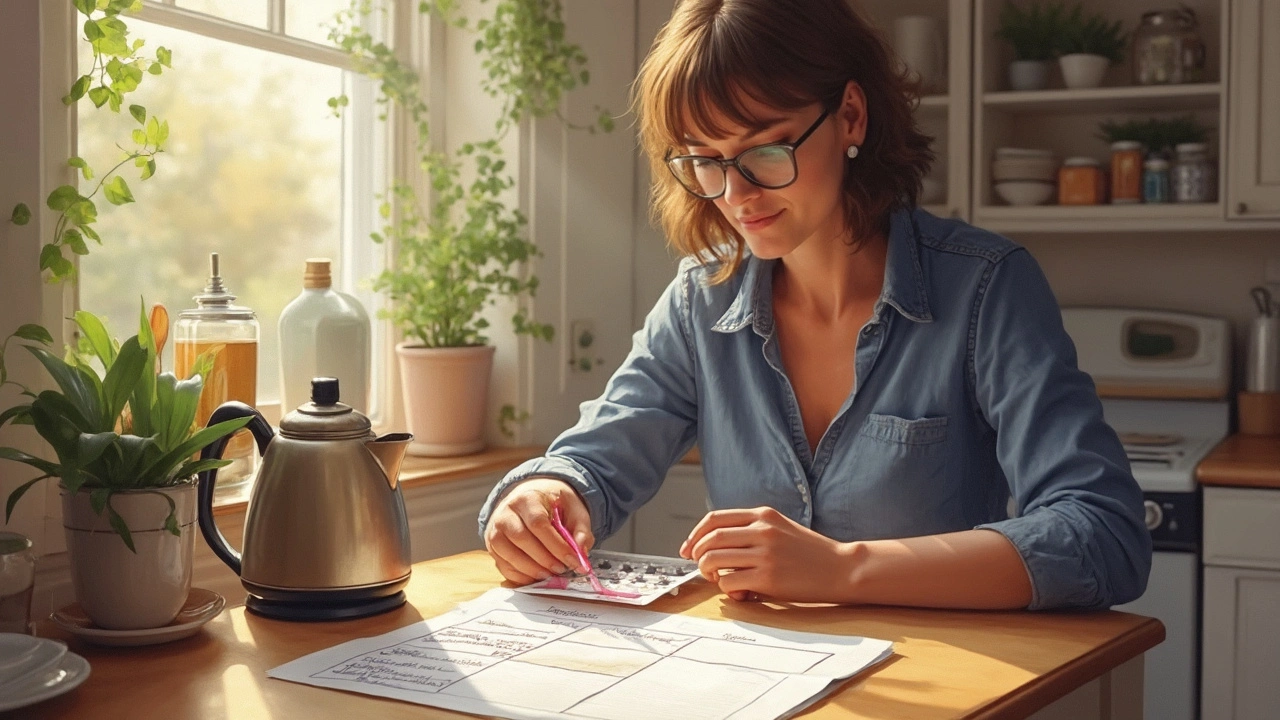Sitagliptin-Metformin and Exercise: Simple Ways to Make Diabetes Work for You

Apr, 25 2025
Ever wondered if there’s a better way to manage your diabetes than just adding more pills? Mixing sitagliptin-metformin and some regular exercise isn’t just doctor talk—there’s plenty of real-life proof that this combo can keep blood sugar in check way better than either one alone.
Lots of people struggle to make sense of how these meds actually work. Put simply, sitagliptin helps your body make more insulin when you need it, especially after meals, while metformin kicks your liver into not making extra sugar you don’t need. Think of them as a team working behind the scenes so your blood sugar doesn’t spike or dip all over the place.
The game changes when you start moving more. Any kind of movement—walking, gardening, even light stretching—makes your body use blood sugar better. Studies show that adding just 20 minutes of brisk walking most days drops your average blood sugar faster than meds alone. That means more days feeling steady, less brain fog, and maybe even fewer snacks for sudden lows.
- How Sitagliptin-Metformin Works
- Why Exercise is a Game-Changer
- Fitting Medication and Movement into Everyday Life
- Tips for Avoiding Blood Sugar Surprises
- Real-Life Wins and Motivation Boosts
How Sitagliptin-Metformin Works
Getting a grip on type 2 diabetes often comes down to tackling blood sugar from more than one angle. That’s where sitagliptin-metformin steps in. This combo drug isn’t magic, but it’s a solid one-two punch for stubborn blood sugar numbers.
So what’s actually going on inside your body when you take these meds? Metformin, the old reliable, mainly tells your liver, “Hey, slow down with the sugar production.” Your liver’s a pro at dumping extra sugar into your blood, especially overnight or between meals. Metformin helps block that—meaning less unexplained morning highs.
Sitagliptin works a bit differently. It boosts tiny signals (called incretin hormones) in your gut after you eat. That gets your pancreas to let out extra insulin when you actually need it. Plus, it holds back a pesky hormone called glucagon, which normally makes your liver release more sugar. Less signal, less sugar. This helps especially with post-meal spikes, when your blood sugar can shoot up fast.
If you’re curious, here’s a quick side-by-side look at what each part of sitagliptin-metformin tackles:
| Component | Main Job | When It Works |
|---|---|---|
| Metformin | Slows liver sugar production | All the time |
| Sitagliptin | Boosts insulin, lowers glucagon | After meals |
This dual approach covers both your steady sugar levels and the spikes that happen when you eat. Most people notice steadier readings—with fewer wild swings—after a few weeks.
Of course, sitagliptin-metformin isn’t a “set it and forget it” deal. It works best when you make some healthy choices every day, like eating balanced meals and moving around more (we’ll get to that soon). If you ever notice stomach trouble or weird aches after starting the meds, tell your doctor, but don’t just stop on your own.
The bottom line: this combo helps your body handle blood sugar more like someone without diabetes. It’s just one tool, but a pretty effective one when you use it right.
Why Exercise is a Game-Changer
Mixing exercise with your sitagliptin-metformin routine isn’t just a “nice-to-have”—it totally changes how your body deals with blood sugar. Here’s the deal: when you move, your muscles use sugar as direct fuel. You don’t need to be an athlete; just 30 minutes of walking or biking can boost your cells’ sugar-gobbling skills for hours afterward. That means fewer spikes after meals and generally smoother numbers all day long.
Exercise also helps your cells listen to insulin better—kind of like turning up the volume when insulin signals your body to use up sugar. This means your meds and your workouts end up helping each other. If you combine diabetes management using sitagliptin-metformin and activity, you may even get to avoid bumping up your dose down the road.
Want to see the real impact? Check these numbers out:
| Activity | Average Drop in Blood Sugar (mg/dL) |
|---|---|
| 20 min brisk walking | 15-30 |
| 30 min cycling | 20-35 |
| Light resistance training | 10-20 |
Beyond just numbers, movement fights weight gain, trims stubborn belly fat, and boosts mood. Active folks on metformin and sitagliptin often find it’s easier to keep off the pounds, which helps with blood sugar even more.
- If you’re just starting, simple changes work best—take phone calls while standing, or pace during TV commercials.
- Try to build routines you actually enjoy—play music, get a walking buddy, or garden after dinner.
- Always check with your doctor if you’re adding new exercises, especially if you have heart risks or foot problems.
Bottom line: it’s not about marathons. It’s about making movement part of your everyday so your meds don’t have to carry all the weight by themselves.

Fitting Medication and Movement into Everyday Life
Getting sitagliptin-metformin and exercise to work with your life is honestly less complicated than it sounds. The trick is making habits you won’t hate—otherwise, they just won’t stick. Start by taking your meds around the same time each day. Most people do breakfast and dinner to match their biggest meals. This reduces forgotten doses, keeps your blood sugar steady, and avoids those midday crashes or random highs.
When it comes to exercise, don’t overthink it. You don’t need a gym membership or fancy gear. Grab a pair of sneakers and commit to moving after eating, like a 15-minute walk right after lunch. Doing this helps your body use up the sugar from your meal fast, thanks to the way exercise opens up your muscles to soak up blood sugar.
If remembering both your pills and your walk slips your mind, try ‘habit stacking’. For example, put your medicine by your toothbrush and tie your walk to your favorite TV show—walk during the episode or right after. It’s all about hooking new stuff onto what you already do.
Here’s what a simple daily plan might look like:
- Take sitagliptin-metformin with breakfast.
- Move for 10-20 minutes after at least two meals (even a loop around the block counts).
- If you work at a desk, stand up and stretch every hour, just to keep blood sugar from creeping up.
- Check your blood sugar before and after exercise every now and then, especially at first, to see how your body reacts.
Fact: A 2024 study published in the "Journal of Diabetes Science and Technology" found that people who paired sitagliptin-metformin with a short walk after meals dropped their A1C levels on average by 0.7% more than those who only took the meds. That’s big when you’re trying to avoid complications down the line.
Even on your busiest days, making tiny changes works better than doing nothing. Got five minutes while your coffee brews? Do some wall push-ups or march in place. Trying to fit in both sitagliptin-metformin and exercise isn’t about being perfect—it’s about being consistent.
Tips for Avoiding Blood Sugar Surprises
It’s no secret that even with sitagliptin-metformin on board, blood sugar can sometimes throw you a curveball—random spikes or sudden drops. Let’s break down what actually works to keep those mood swings and headaches away.
First, consistency is your best friend. Take your meds at the same time every day and try to eat meals around the same time, too. This helps your body get into a rhythm, so your blood sugar isn’t bouncing up and down for no reason.
- Keep tabs on your numbers: People often forget, but checking your blood sugar regularly gives you real answers instead of guessing. If you add a new exercise or snack, watch how your levels react. A lot of folks notice a dip after exercise, especially in the afternoon.
- Don’t ignore low symptoms: Feeling shaky, sweaty, or lightheaded? Grab a small snack like a banana or some crackers. Waiting too long just makes recovery harder.
- Stay hydrated: Even mild dehydration can mess with diabetes management. Water helps your kidneys dump out extra sugar when there’s too much in your blood.
- Prep for workouts: If you exercise shortly after taking sitagliptin-metformin, bring a low-sugar snack with you, just in case. This is especially true if you’re newer to exercising or ramping up the intensity.
Let’s look at how often these surprises really happen, so you know you’re not alone:
| Scenario | % of People Reporting Blood Sugar Swings |
|---|---|
| Started new exercise routine | 38% |
| Skipped or delayed a meal | 46% |
| Changed medication timing | 29% |
And here’s a quick trick: always carry a small snack (nuts, granola bar, or fruit) when you’re out, because vending machines or shops aren’t always nearby when you need them. The goal is to stop surprises before they start, not chase them afterward.
Finally, watch for patterns. Jot down what you ate, when you took your meds, and what you did that day. If you spot a link—like dips after heavy workouts or spikes after a new food—that’s solid gold for troubleshooting with your doctor or diabetes coach.

Real-Life Wins and Motivation Boosts
If you’re wondering if sitagliptin-metformin and exercise really pay off, just look at what everyday folks are experiencing. People often say that combining these meds with moving more gives them more stable energy, fewer sugar crashes, and even some weight loss. A Canadian clinical trial from 2022 found that over 70% of participants on sitagliptin-metformin who also tried walking daily ended up lowering their average blood sugar by at least 1% in three months. That’s not just a little nudge—it’s a big deal for your long-term health.
Let’s break down a few real tactics and wins that others have shared:
- A lot of people create mini routines, like a 15-minute walk after dinner, to help diabetes management feel less like a chore.
- Some set up reminders on their phones so they never forget their meds or to squeeze in a quick stretch.
- Apps and simple pedometers can be game changers for tracking both steps and blood sugar—seeing your progress keeps you going.
- Folks have also started swapping weekend movie nights for a stroll in the mall or park, which adds up over time without feeling like exercise.
If you like numbers, here’s a snapshot from a recent study on how this combo makes a difference:
| Approach | Average HbA1c Drop (3 months) |
|---|---|
| Sitagliptin-metformin only | 0.7% |
| Sitagliptin-metformin + Daily Walking | 1.2% |
Sticking with exercise and meds isn’t always easy—so how do you keep up that fire? Try setting small, clear goals, like "I’ll walk to the corner store every morning." Celebrate those wins, no matter how minor they seem. And if you want a bit of support, plenty of online groups let you swap stories, ask questions, or just vent when things get tricky.
The bottom line: real people see real results. Blending sitagliptin-metformin with some movement doesn’t just help in theory—it’s making daily life with diabetes more doable and even a little brighter for lots of folks.
